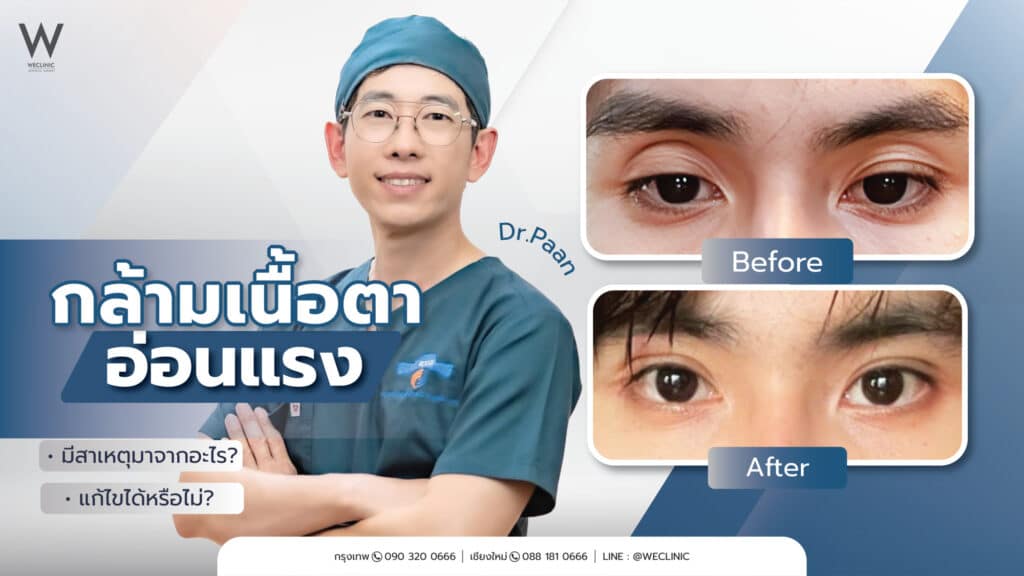
Many people notice that their eyelids appear uneven, with one or both sides drooping more than usual. This condition is commonly linked to weak eye muscles, which can develop from a variety of causes. If you often look in the mirror and feel concerned about your uneven double eyelids, it’s important to understand what weak eye muscles really mean and how this condition develops.
In this article, we break down the underlying causes of weak eye muscles, how to identify the signs, how severe the condition can be, and whether it can be effectively treated. Let’s take a closer look.
What Are Weak Eye Muscles?
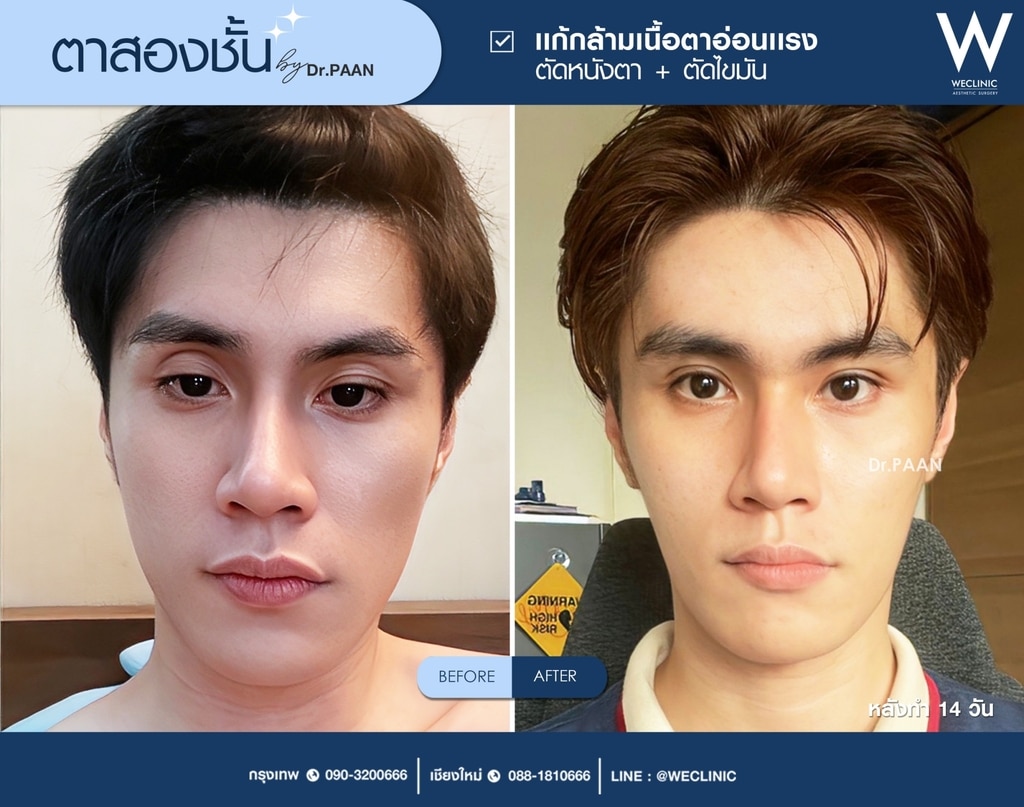
“Weak eye muscles” can be a sign of an underlying autoimmune disorder that affects the connection between the nerves and the muscles. In medical terms, this condition is often related to myasthenia gravis (MG), which can involve several muscle groups in the body. In this article, however, we will focus specifically on the ocular form, where the muscles that control eye and eyelid movement are affected.
When the eye muscles become weak, patients may experience droopy eyelids, difficulty keeping the eyes fully open, double vision, or trouble focusing on objects. These symptoms often come and go, and may fluctuate throughout the day depending on rest, fatigue, and overall health.
Because weak eye muscles can sometimes progress and affect other parts of the body, it is very important to monitor symptoms closely and seek proper medical evaluation.
Weak Eye Muscles in One Eye
In some patients, weak eye muscles affect only one side, causing mild drooping of the upper eyelid. This may show up as uneven double eyelids, difficulty matching eye makeup, or eyes that look slightly sleepy or tired all the time. Even though the condition is not severe, it can still affect facial balance and self-confidence.
In cases like this, the problem can often be improved with eyelid correction surgery, which helps adjust the eyelid crease and lift the drooping lid so that both eyes look more symmetrical and refreshed.
Weak Eye Muscles vs. Ptosis vs. Dermatochalasis
สิ่งที่คล้ายกันของทั้งสามโรคอย่างกล้ามเนื้อตาอ่อนแรง ภาวะหนังตาตก และผิวหนังเปลือกตาหย่อนเลยคือการมีชั้นตาที่ไม่สวยงาม อาจจะตกหรือปรือ ลืมตาแล้วไม่เท่ากัน แต่ว่าเราจะรู้ได้อย่างไรว่าภาวะที่เผชิญอยู่นี้เป็นเพราะโรคอะไรกันแน่
1. Weak Eye Muscles (Ocular Myasthenia Gravis)
Ocular myasthenia gravis, often referred to as MG, is an autoimmune condition in which the body produces antibodies that interfere with the communication between nerves and the eye muscles. This affects both the muscles that lift the eyelids and the extraocular muscles that control eye movement.Patients may experience droopy eyelids, difficulty keeping the eyes open, trouble moving the eyes, double vision, or problems focusing.
In more severe cases, MG can also affect swallowing or breathing, so anyone showing these symptoms should seek evaluation from a specialist especially because similar symptoms can sometimes indicate other medical conditions.
2. Ptosis (Eyelid Drooping)
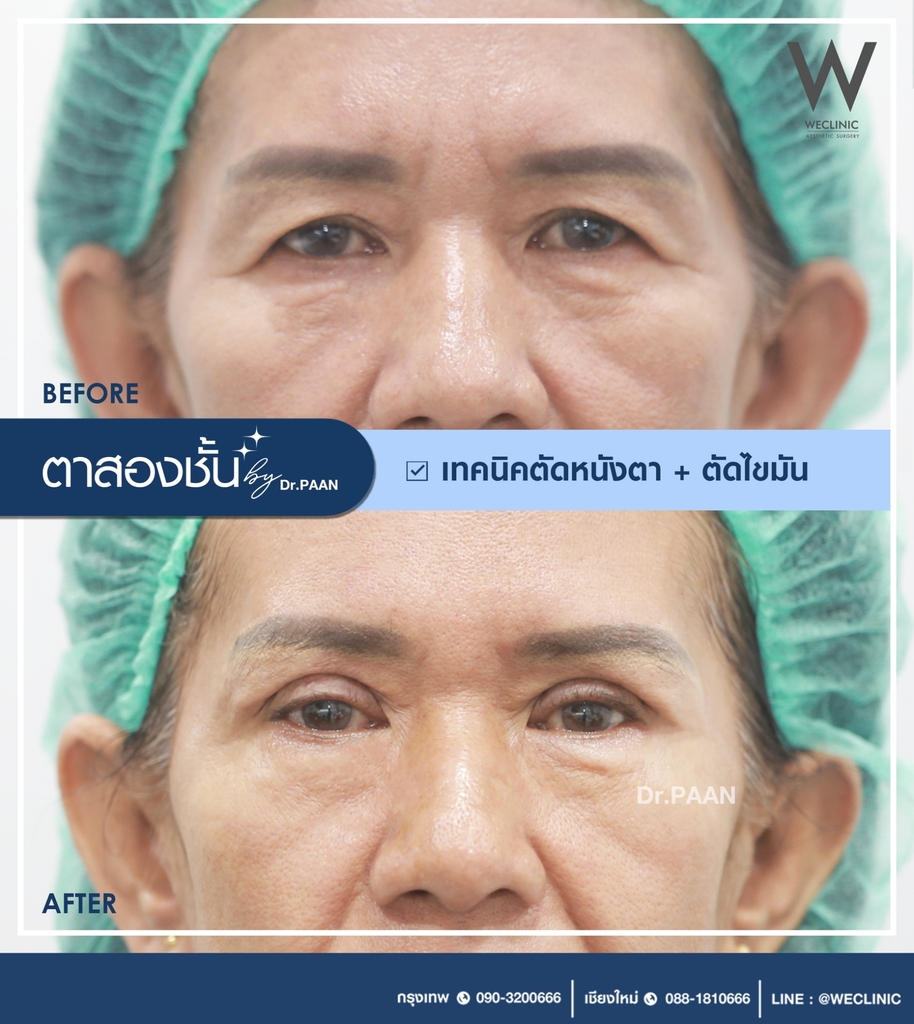
Ptosis or drooping of the upper eyelid may be related to weak eye muscles, but not always. It is commonly found in patients who previously had eyelid surgery, especially if the procedure disrupted the natural function of the levator muscle.
Symptoms may include:
- eyelids that cannot fully open on one side
- irritation or discomfort
- noticeably uneven eyelid creases
Because ptosis can result from surgical complications, it is essential to choose an experienced surgeon when considering double eyelid surgery.
3. Dermatochalasis (Sagging Eyelid Skin)
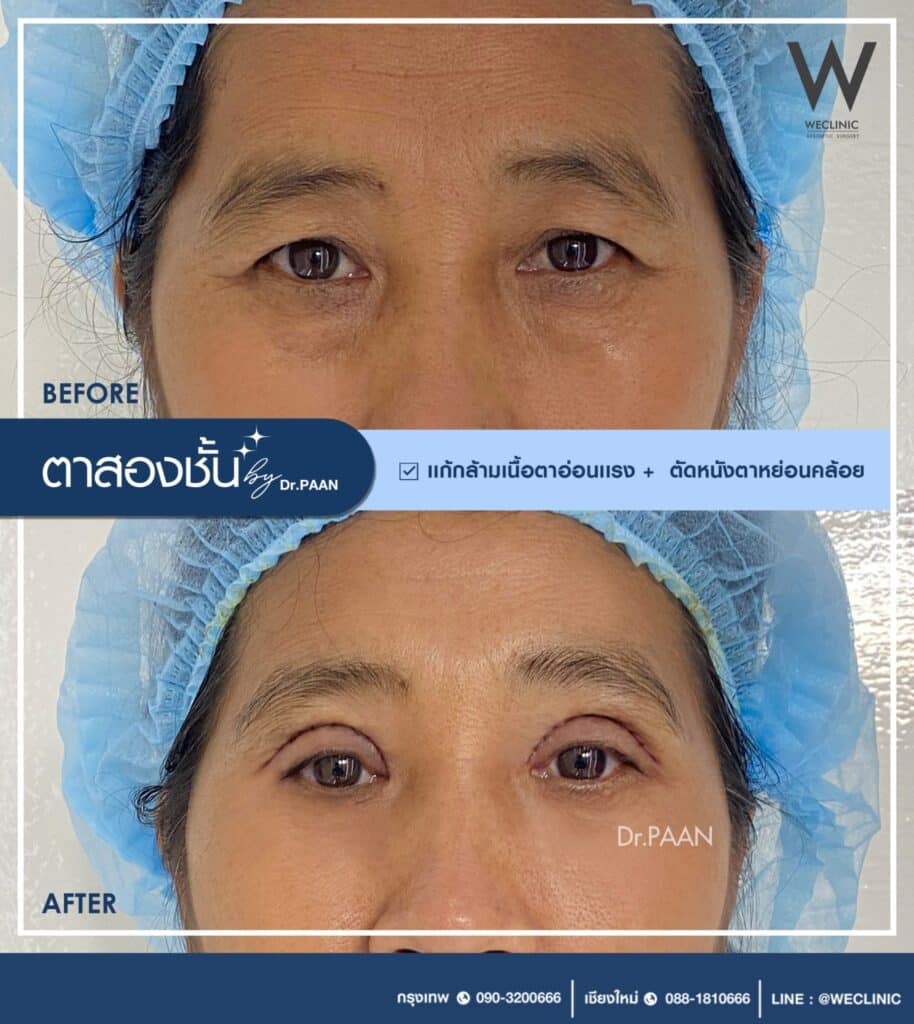
Dermatochalasis refers to excess or sagging skin on the upper eyelid, often caused by aging, but it can also be triggered by frequent eye rubbing, chronic inflammation, or underlying tissue abnormalities. The loose skin may droop over the eye and obstruct vision.
Fortunately, dermatochalasis can be corrected through eyelid surgery to remove excess skin and restore a more open, refreshed eye appearance.
Symptoms of Weak Eye Muscles
Weak eye muscles (Ocular Myasthenia Gravis) can cause a wide range of symptoms, many of which overlap with other eye conditions. Because these signs may not always point to the same diagnosis, anyone experiencing similar symptoms should consult a specialist for proper evaluation. Below are the most common symptoms to watch for:
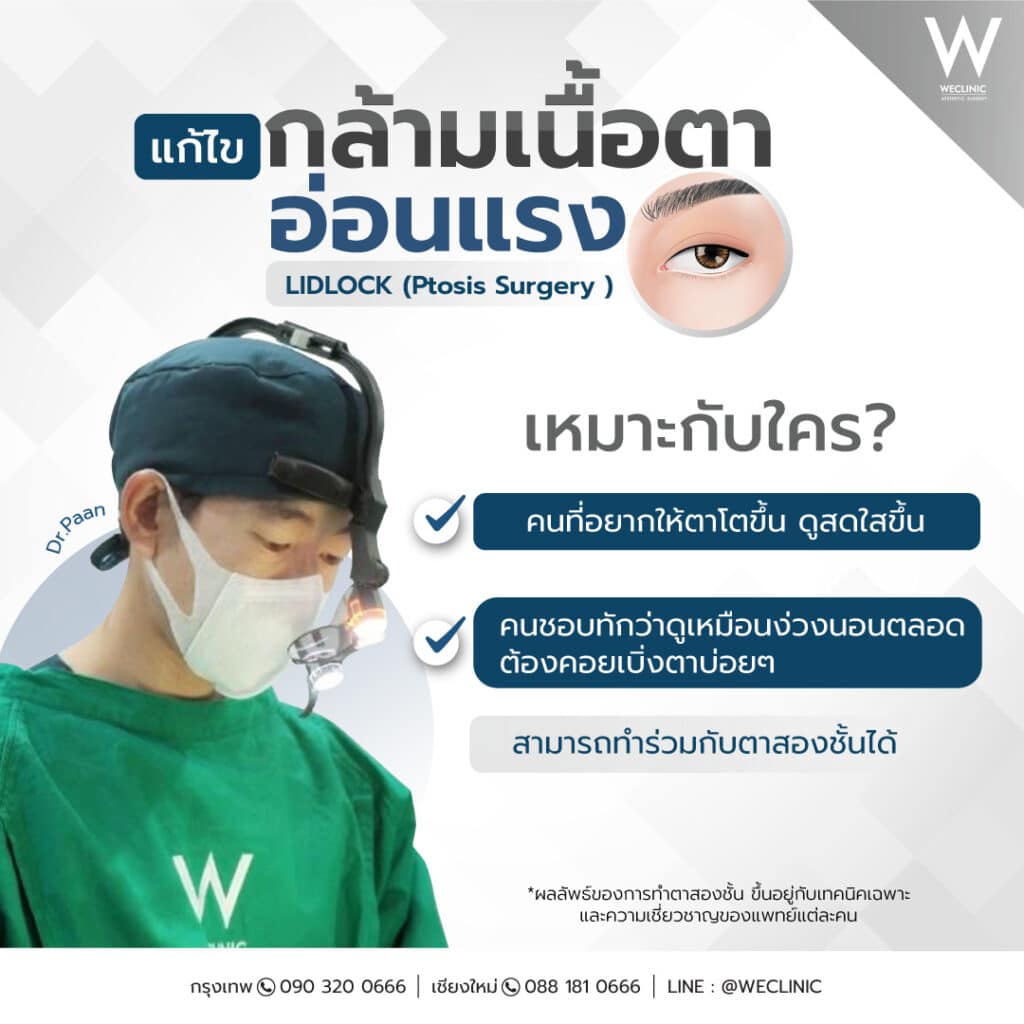
1. Droopy or Heavy Eyelids, Tired-Looking Eyes
Patients may appear sleepy, tired, or have difficulty lifting the upper eyelids fully. The eyelid margin cannot open to its normal position because the eyelid muscles are too weak. This can occur in one eye or both, leading to uneven eyelid creases, asymmetry, and difficulty applying eye makeup.
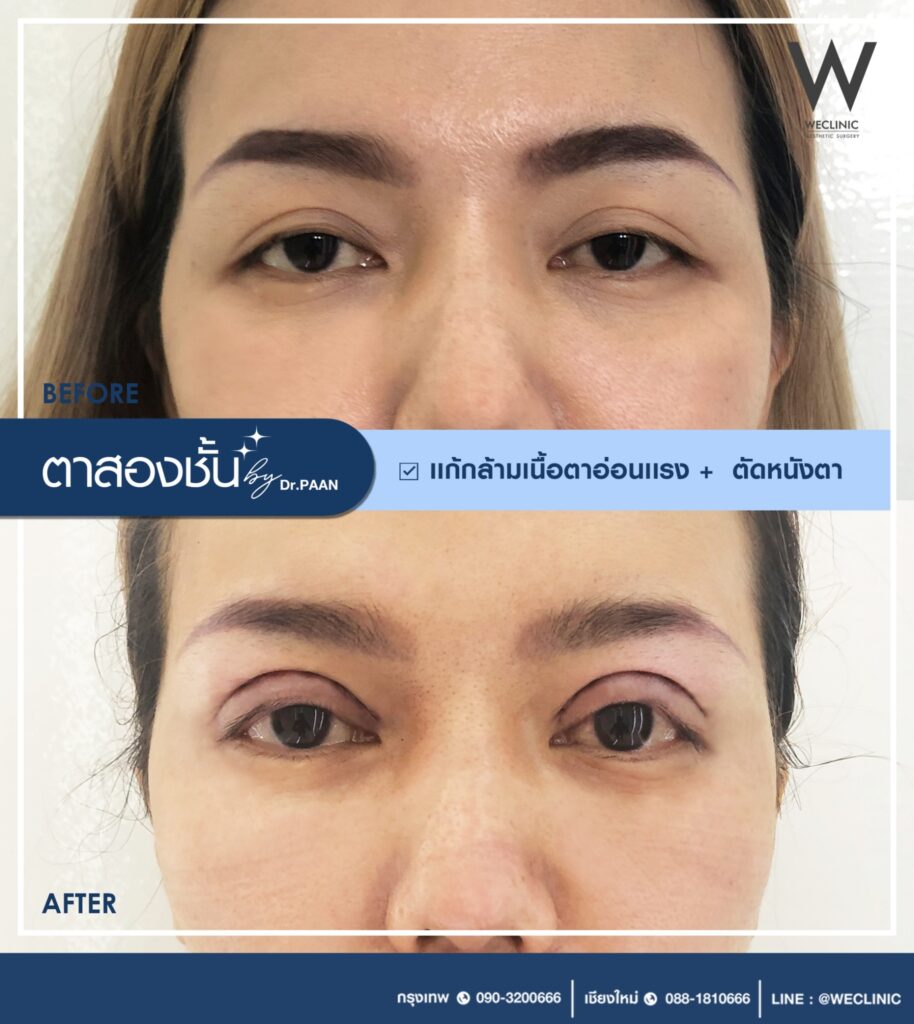
2. Lazy Eye and Difficulty Moving the Eyes
When the muscles responsible for eye movement become weak, the eyes may not move together smoothly. One eye may work harder than the other, creating strain and imbalance. Over time, this can contribute to amblyopia (lazy eye), especially if there is a large difference in eye usage or focusing ability.
3. Uneven Pupillary Opening or Crossed Eyes (Strabismus)
Unequal eyelid opening and strabismus (crossed or misaligned eyes) can also be associated with weak eye muscles.
- Uneven openings occur when the eyelid on one side cannot lift as high as the other.
- Strabismus may result from weak extraocular muscles failing to coordinate properly.
- In some patients, a narrow inner canthus can also make the eyes appear misaligned.
4. Sunken or Deep Eye Sockets
Some patients develop a deep-set eyelid crease or hollow appearance, making the eyes look tired or “sunken.” This may be age-related but can also appear in cases of weak eye muscles when the eyelids fail to lift properly, creating an exaggerated crease.

5. Visual Disturbances and Double Vision
Because the eye muscles do not work in harmony, patients may experience:
- double vision
- blurred or unstable focus
- difficulty maintaining visual alignment
In severe cases, the images seen by the two eyes may separate entirely.
6. Unconscious Brow Lifting or Facial Muscle Tension
The body may try to compensate for weak eyelid muscles by overusing the forehead or eyebrow muscles. Patients may repeatedly raise their brows or tense the surrounding facial muscles without realizing it, which can lead to discomfort and exacerbate fatigue around the eyes.
Severity Levels of Weak Eye Muscles
The severity of weak eye muscles can vary significantly from person to person, depending on the underlying causes. Some individuals may live normally without needing treatment, while others experience more serious symptoms that require medical attention. If you’re unsure when it’s the right time to see a specialist, the following classification can help you understand the levels of severity:
Level 1: Mild (Early Stage)
In the mildest form, the upper eyelid droops slightly, covering more than 2 mm of the pupil when the eyes are open. This is considered the earliest stage of weak eye muscles and usually does not cause major functional problems.
Level 2: Moderate
Here, the upper eyelid covers more than 3 mm of the pupil. At this point, the symptoms become more noticeable, and the drooping is clearly visible. Consulting an eye specialist is recommended to identify the cause and consider appropriate treatment options.
Level 3: Severe
In the most serious stage, the upper eyelid covers more than 4 mm of the pupil. This level of drooping can interfere with vision and should be evaluated by a doctor as soon as possible to determine proper management and treatment.
Are Weak Eye Muscles Dangerous If Left Untreated?
Weak eye muscles can become concerning if left unmanaged, especially when symptoms progress to a more severe stage. In advanced cases, the drooping eyelid may significantly obstruct vision, making everyday activities more difficult and affecting overall quality of life.
Beyond functional problems, the condition may also impact one’s appearance. Some individuals may need to tilt their head back or lift their eyebrows constantly in an effort to see more clearly leading to fatigue and changes in facial posture.

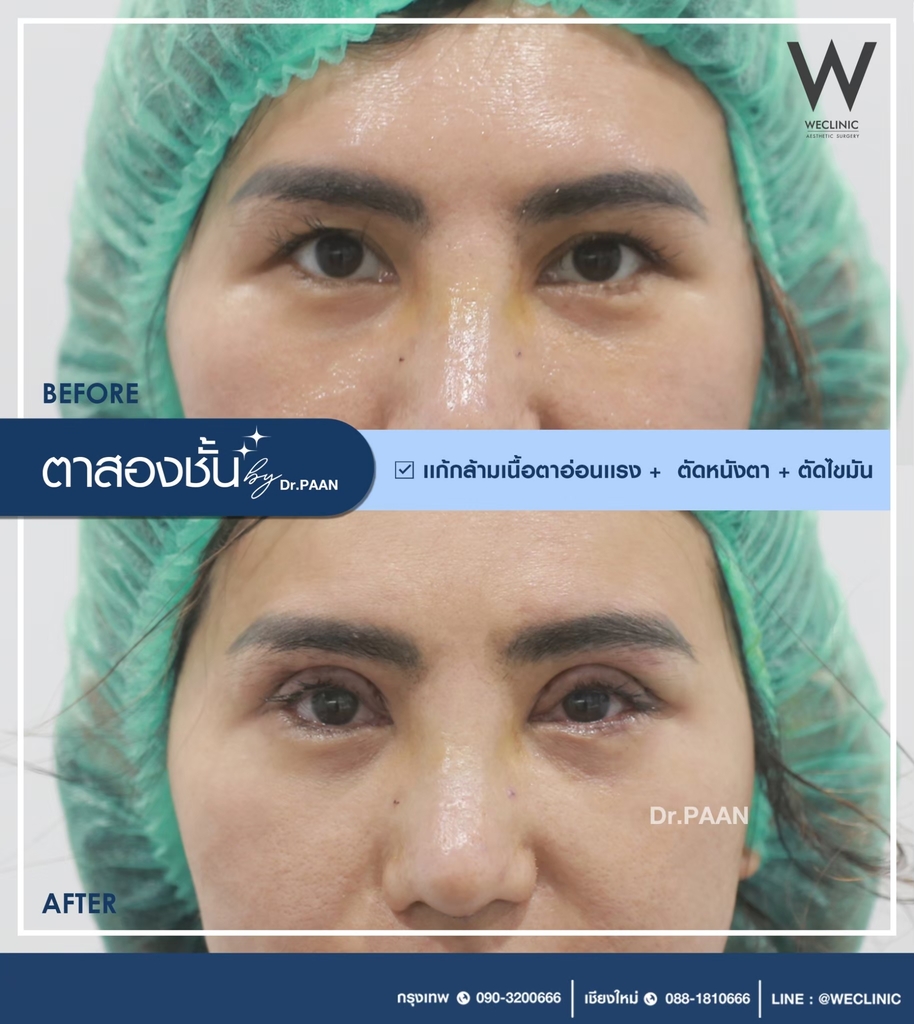
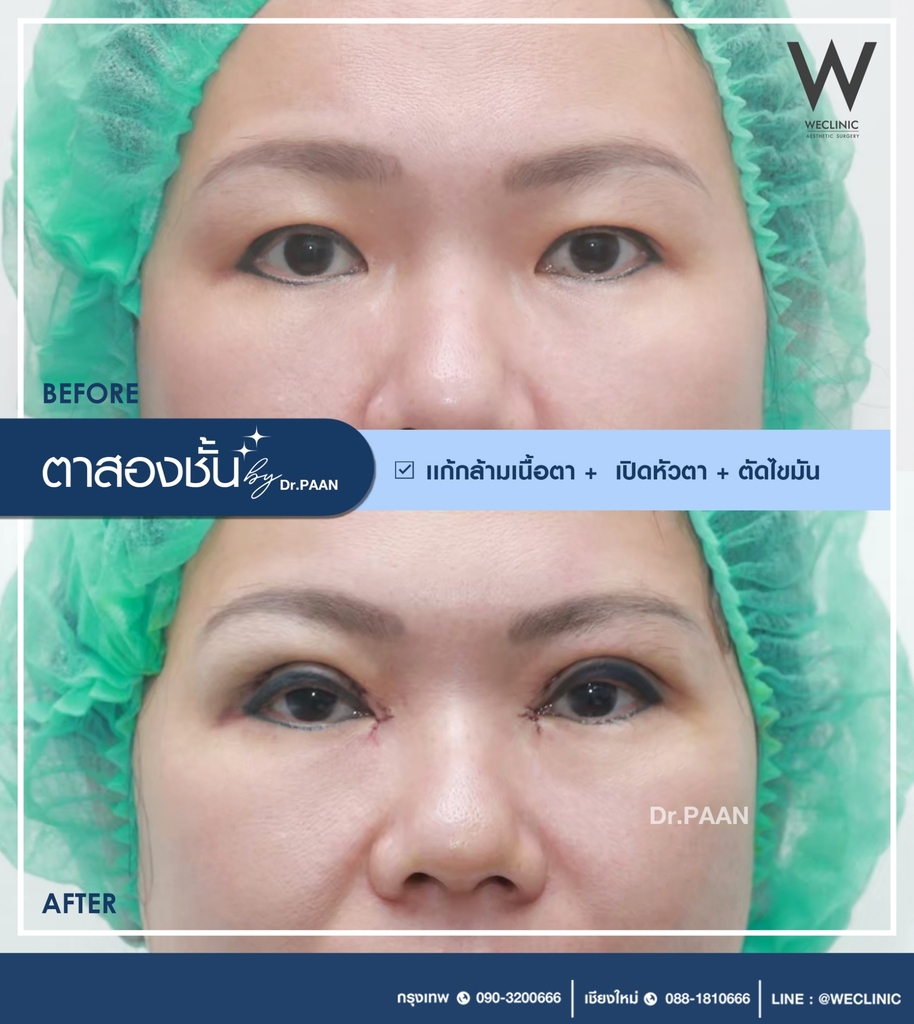
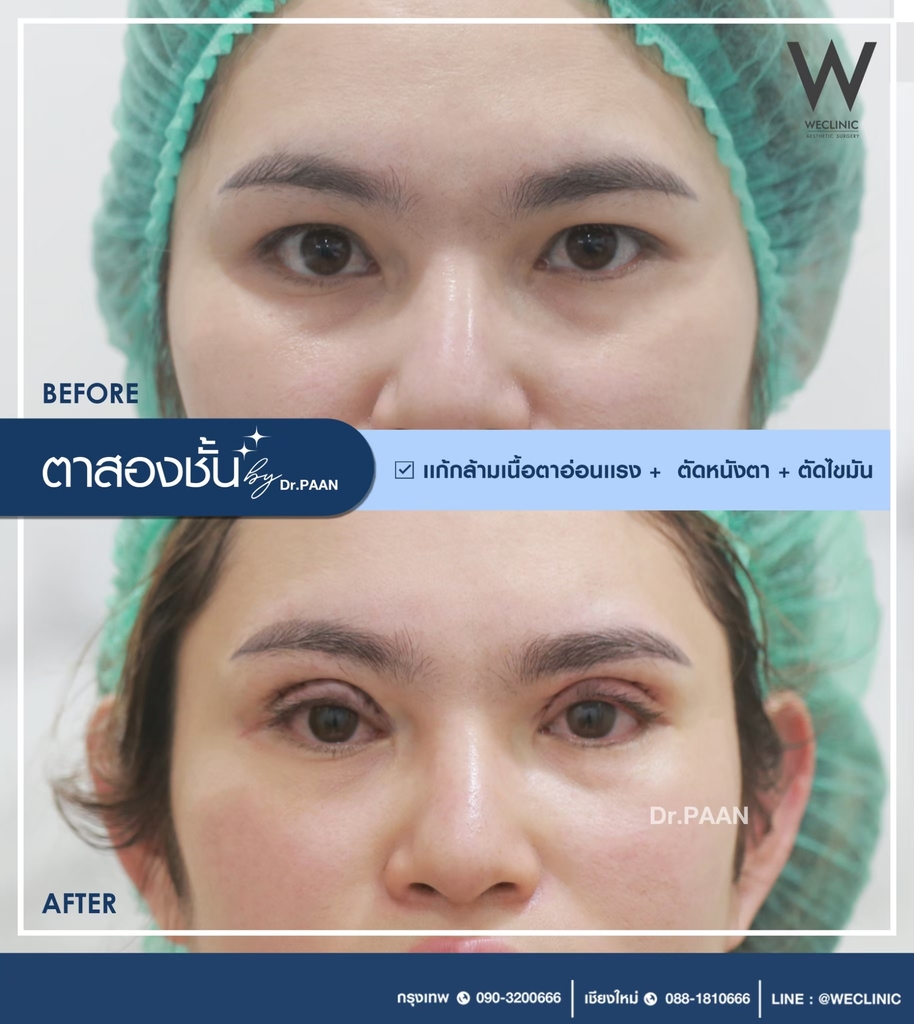
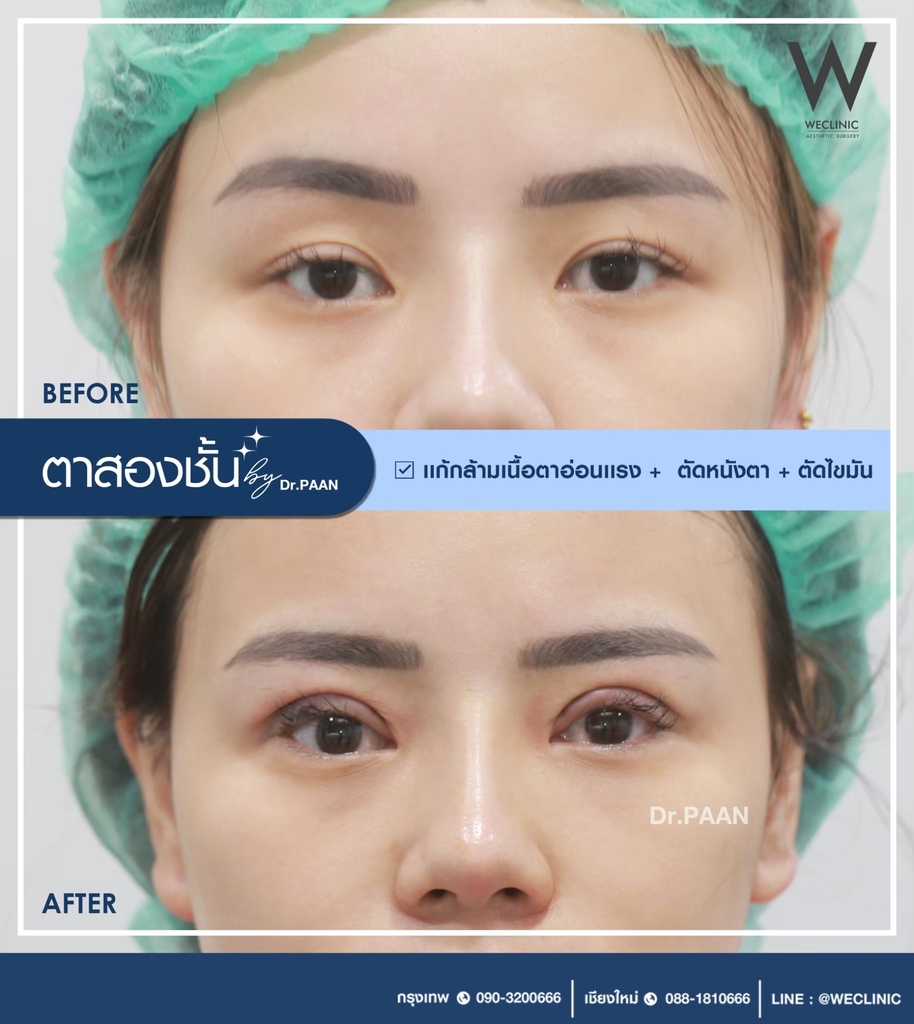

What Causes Weak Eye Muscles?
Weak eye muscles can develop when the immune system malfunctions and interferes with the neurotransmitters responsible for sending signals to the muscles. When these signals become weakened, the muscles cannot function normally. Although the exact cause of this condition is still unclear, several contributing factors have been identified:

1. Genetics
Some individuals experience weak eye muscles due to genetic or congenital factors. This can be noticeable from childhood, often presenting as underdeveloped eye muscles or abnormalities in the cranial nerves that control eyelid movement. Children may appear sleepy, have difficulty opening their eyes fully, or develop conditions like astigmatism or amblyopia (lazy eye).
Studies also show that Ocular Myasthenia Gravis can coexist with thyroid disorders in about 10–15% of cases. Therefore, individuals with thyroid disease who develop unusual eyelid symptoms should seek medical evaluation.
2. Aging
Age is a common contributor to weak eye muscles. Even with proper eye care avoiding rubbing, tugging on the eyelids, or wearing contact lenses excessively the tissues around the eyes naturally lose elasticity over time. As the eyelid skin becomes looser and the supporting muscles weaken, drooping and eyelid fatigue can occur.
3. Environmental and Lifestyle Factors
Certain behaviors and daily habits can gradually strain or injure the eyelid muscles. These include:
- prolonged computer or screen use
- frequent eye rubbing
- wearing contact lenses regularly
- overuse of the eyes during focusing-intensive tasks
These activities can stretch or irritate the muscles and tissues around the eyes, leading to dysfunction and eventually weak eye muscles.
4. Other Immune-Related Causes
Weak eye muscles may also occur during periods when the immune system is compromised commonly seen in individuals who:
- sleep poorly
- are pregnant
- have diabetes
- are living with HIV
In some cases, the condition may be related to abnormalities of the 7th cranial nerve, which controls facial muscles. This can lead to Bell’s palsy, a temporary facial muscle weakness that causes difficulty raising the eyebrows or closing the eyes completely.
Most cases of Bell’s palsy improve on their own without surgery.
How to Treat Weak Eye Muscles
Treatment for weak eye muscles depends on the underlying cause and the severity of the condition. In general, there are three main approaches:
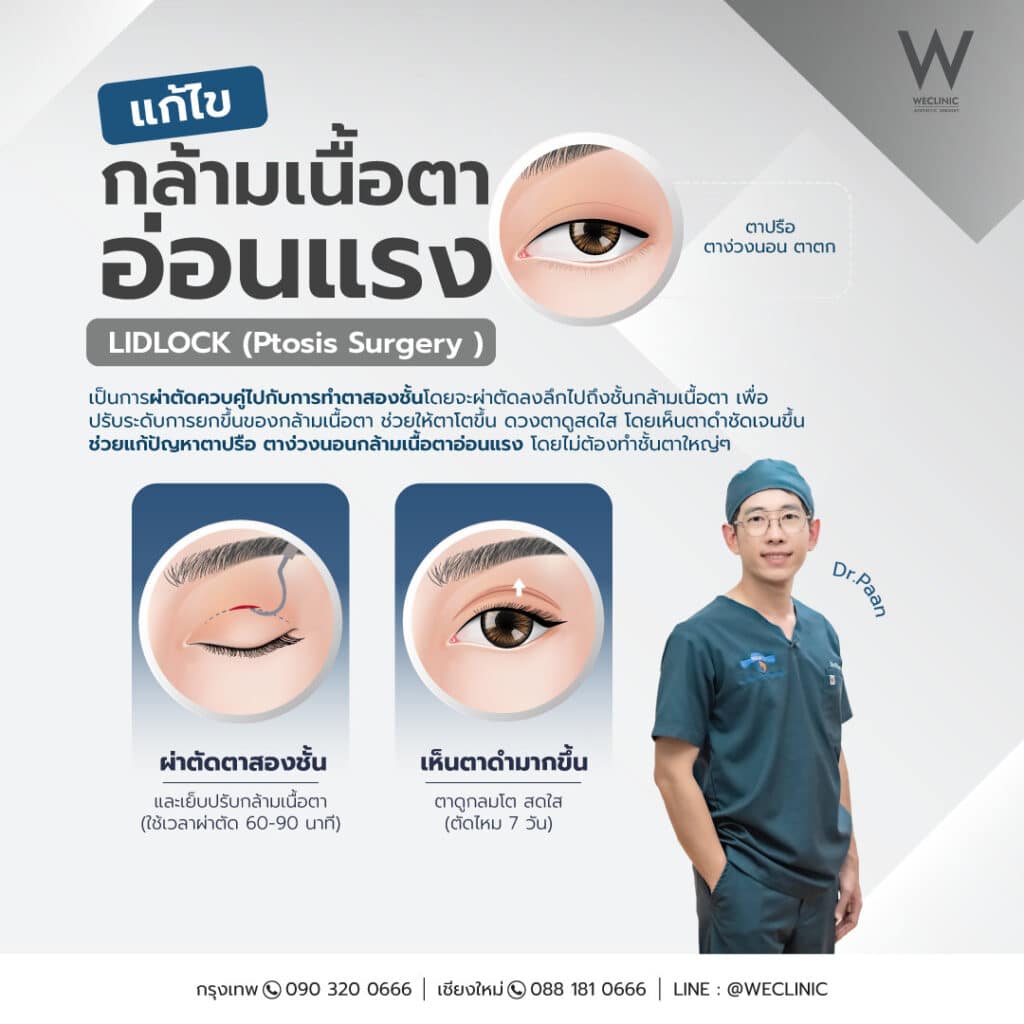
1. Eyelid and Eye Muscle Exercises (For Mild Weakness)
For individuals with early-stage weak eye muscles where the upper eyelid covers more than 2 mm but less than 3 mm of the pupil, certain exercises may help improve eyelid control and muscle strength.
• Focus Adjustment Exercise
Hold an object (or your hand) at eye level and slowly bring it toward your eyes while maintaining focus. When double vision occurs, return to the starting position and repeat.
Do this 20 times per session, 3 times a day, for about 3 weeks.
• Eye Movement Exercise
Move your eyes in four directions: upward, downward, left, and right.
Repeat this exercise twice daily for at least 3 weeks.
These exercises may help reduce mild eyelid drooping and support better muscle coordination.
2. Treating Immune-Related Causes
Since weak eye muscles often stem from autoimmune dysfunction, medication can be an effective and targeted approach. Depending on the diagnosis, doctors may prescribe:
- medications that enhance neurotransmitter activity
- steroids
- immunosuppressive drugs
A specialist will determine the appropriate medication and treatment plan based on the patient’s condition.
3. Eyelid Surgery or Double Eyelid Correction
For mild moderate cases, eyelid surgery can help improve eyelid opening by adjusting and strengthening the levator muscle. This procedure provides fast and noticeable results, allowing the eyelid to lift more effectively.
Surgery can also be combined with a double eyelid (eyelid crease) procedure to create a more balanced and aesthetically pleasing eyelid shape.
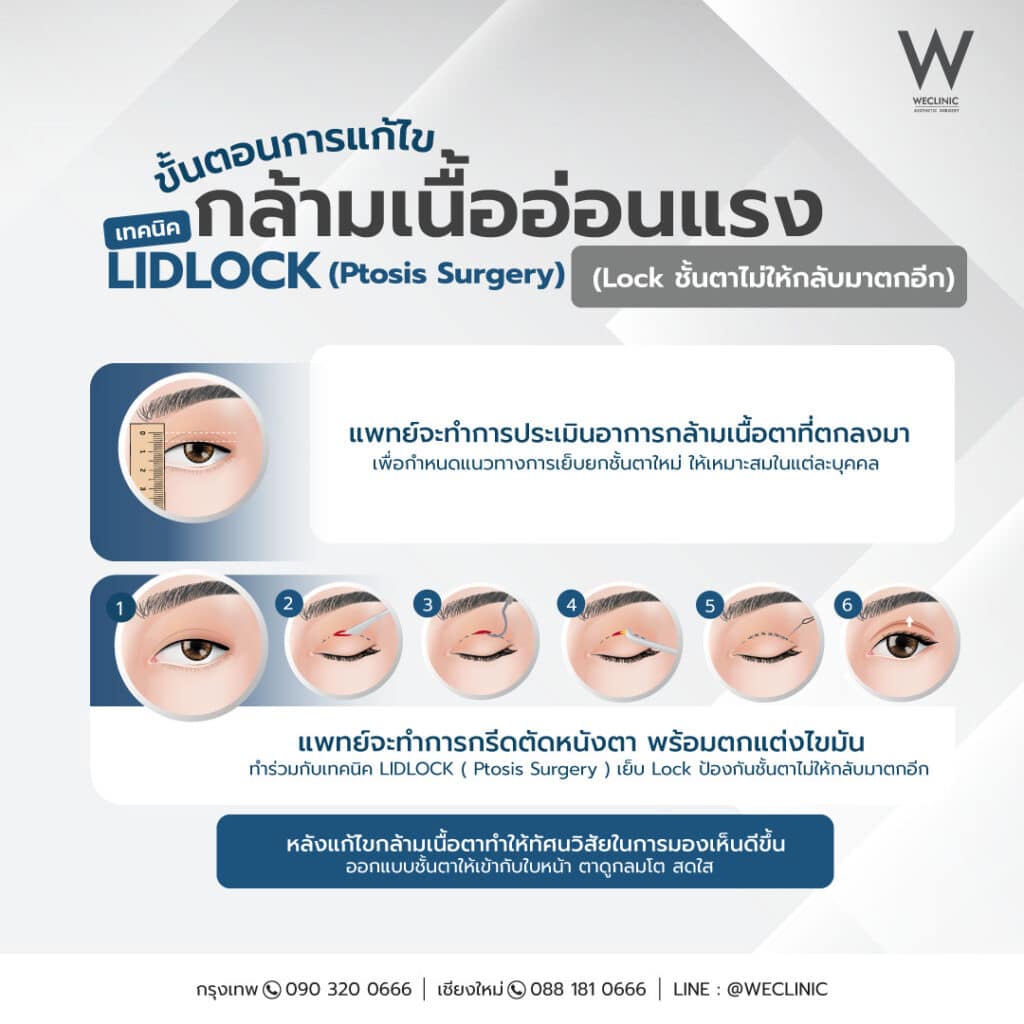
How Much Does Weak Eye Muscle Treatment Cost?
The cost of treating weak eye muscles can be relatively high, as it often involves delicate correction around the eyelids and eye muscles. A thorough evaluation by an experienced specialist is required, and the total fee will vary depending on each person’s condition, diagnosis, and treatment plan.
If eyelid surgery or double eyelid correction is performed at the same time, the overall cost will be higher, as it includes both functional correction and aesthetic refinement.
Benefits of Surgery for Weak Eye Muscles
One of the most important benefits of surgery for weak eye muscles is improved vision. By lifting the droopy eyelid, patients can open their eyes more fully without having to constantly raise their eyebrows or tilt their head back to see clearly.
This not only enhances visual function, but also significantly improves overall appearance and confidence. With both eyes opening more symmetrically, applying eye makeup becomes easier and more precise.
For those who undergo double eyelid surgery at the same time, the result is even more refined; the eyelid crease can be designed to match the patient’s facial features, creating brighter, more youthful-looking eyes.
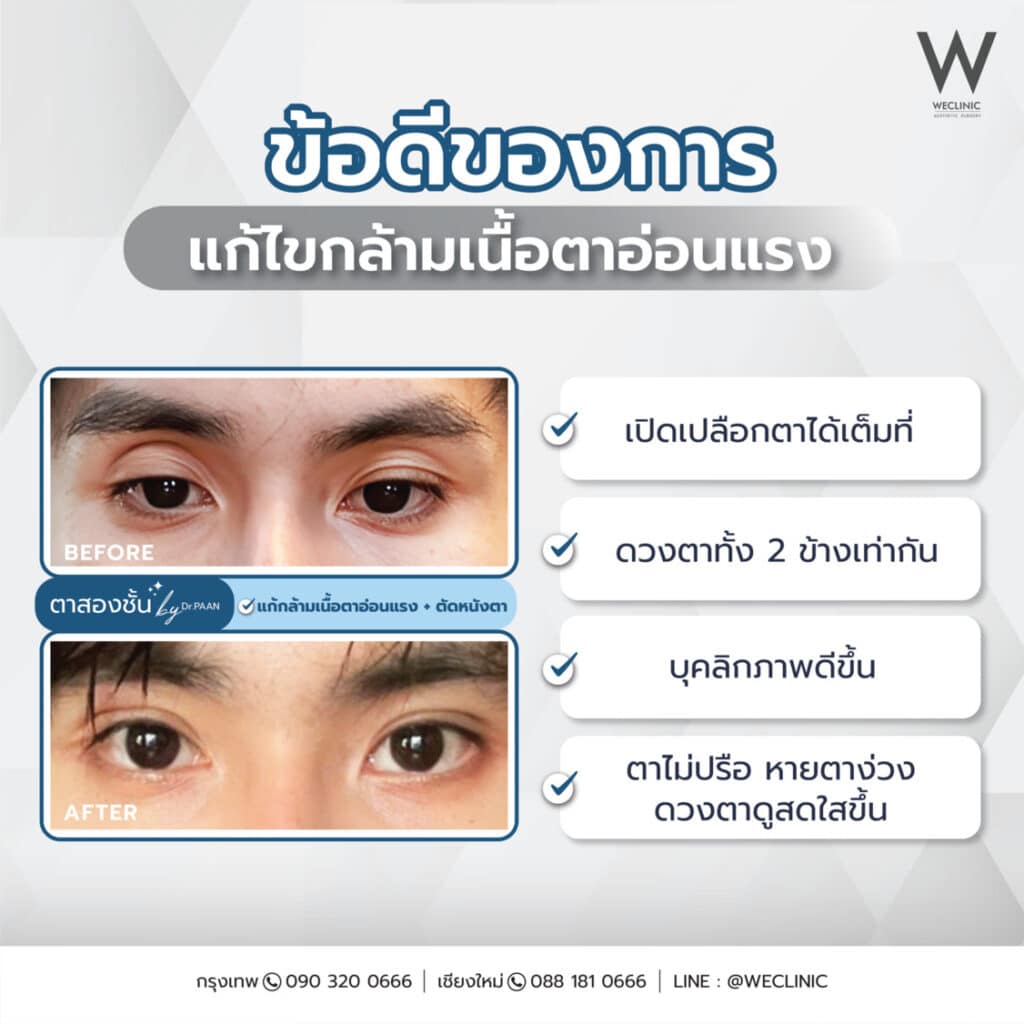
Frequently Asked Questions
Can weak eye muscles be treated without surgery?
Yes. In some cases, weak eye muscles can be managed without surgery. Treatment may include eye and eyelid exercises or medications prescribed by a specialist, especially when the condition is related to the immune system.
However, these methods usually require consistent treatment over a longer period of time, and the results may not be as quick or as dramatic as surgical correction.
Summary
In summary, weak eye muscles can develop from many different causes, and in many cases, the exact underlying trigger is not fully understood. The good news is that this condition can often be improved with eyelid surgery that adjusts and strengthens the muscles responsible for lifting the upper eyelid, allowing the eyes to open more fully and function better.
However, any surgical correction around the eyes should be performed only after a thorough consultation with an experienced specialist to minimize the risk of complications and to design a treatment plan that suits each individual patient.
In addition to medical treatment, it is also important to protect the eye area in daily life by avoiding habits such as rubbing the eyes, staying up late, or overusing the eyes for long periods without rest, as these behaviors may further aggravate eyelid and muscle problems over time.





สำหรับผู้อ่านทุกท่านที่มีข้อสงสัยเพิ่มเติม ทีมแพทย์ We Clinic ยินดีให้คำปรึกษาฟรี
โดยไม่มีค่าใช้จ่าย หรือสามารถปรึกษาหมอทาง facebook หรือ Line ได้ที่นี่เลยครับ